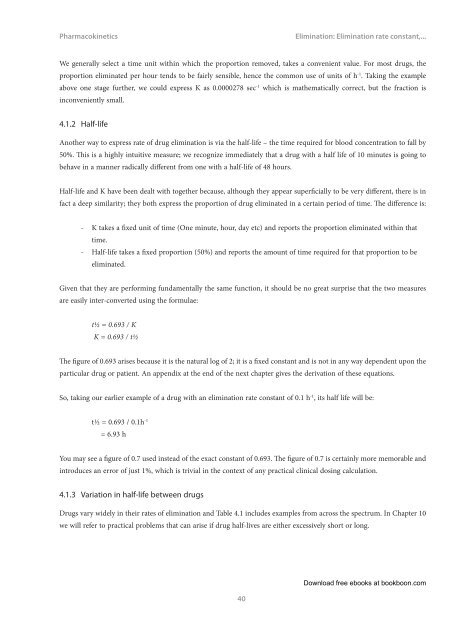Pharmacokinetics Language English Format: PDF Price - Tutorsindia
Pharmacokinetics Language English Format: PDF Price - Tutorsindia
Pharmacokinetics Language English Format: PDF Price - Tutorsindia
- No tags were found...
You also want an ePaper? Increase the reach of your titles
YUMPU automatically turns print PDFs into web optimized ePapers that Google loves.
<strong>Pharmacokinetics</strong>Elimination: Elimination rate constant,...We generally select a time unit within which the proportion removed, takes a convenient value. For most drugs, theproportion eliminated per hour tends to be fairly sensible, hence the common use of units of h -1 . Taking the exampleabove one stage further, we could express K as 0.0000278 sec -1 which is mathematically correct, but the fraction isinconveniently small.4.1.2 Half-lifeAnother way to express rate of drug elimination is via the half-life – the time required for blood concentration to fall by50%. This is a highly intuitive measure; we recognize immediately that a drug with a half life of 10 minutes is going tobehave in a manner radically different from one with a half-life of 48 hours.Half-life and K have been dealt with together because, although they appear superficially to be very different, there is infact a deep similarity; they both express the proportion of drug eliminated in a certain period of time. The difference is:--K takes a fixed unit of time (One minute, hour, day etc) and reports the proportion eliminated within thattime.--Half-life takes a fixed proportion (50%) and reports the amount of time required for that proportion to beeliminated.Given that they are performing fundamentally the same function, it should be no great surprise that the two measuresare easily inter-converted using the formulae:t½ = 0.693 / KK = 0.693 / t½The figure of 0.693 arises because it is the natural log of 2; it is a fixed constant and is not in any way dependent upon theparticular drug or patient. An appendix at the end of the next chapter gives the derivation of these equations.So, taking our earlier example of a drug with an elimination rate constant of 0.1 h -1 , its half life will be:t½ = 0.693 / 0.1h -1= 6.93 hYou may see a figure of 0.7 used instead of the exact constant of 0.693. The figure of 0.7 is certainly more memorable andintroduces an error of just 1%, which is trivial in the context of any practical clinical dosing calculation.4.1.3 Variation in half-life between drugsDrugs vary widely in their rates of elimination and Table 4.1 includes examples from across the spectrum. In Chapter 10we will refer to practical problems that can arise if drug half-lives are either excessively short or long.40Download free ebooks at bookboon.com
















